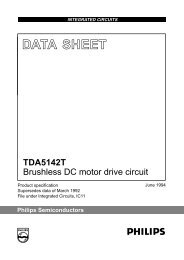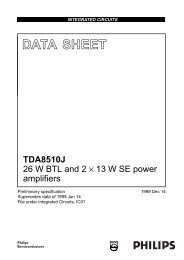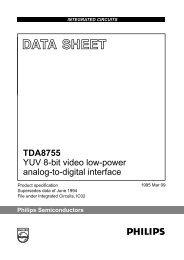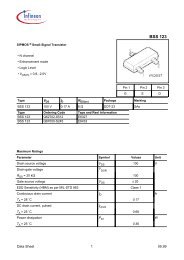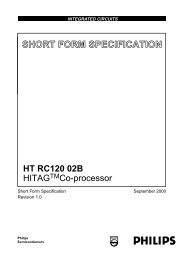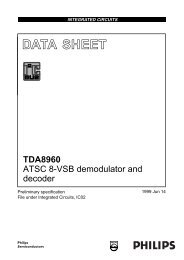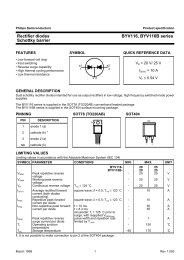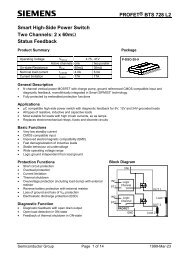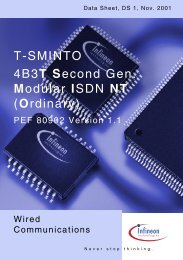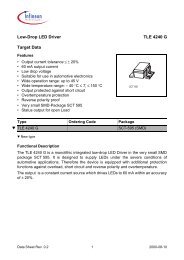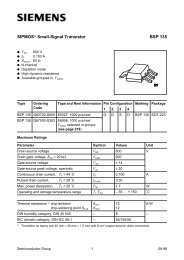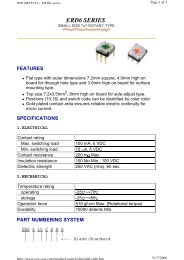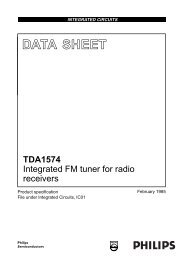Create successful ePaper yourself
Turn your PDF publications into a flip-book with our unique Google optimized e-Paper software.
<strong>MCP606</strong>/7/8/9<br />
2.5V to 6.0V Micropower CMOS Op Amp<br />
Features<br />
• Low Input Offset Voltage: 250 µV (maximum)<br />
• Rail-to-Rail Output<br />
• Low Input Bias Current: 80 pA (maximum at<br />
+85°C)<br />
• Low Quiescent Current: 25 µA (maximum)<br />
• Power Supply Voltage: 2.5V to 6.0V<br />
• Unity-Gain Stable<br />
• Chip Select (CS) Capability: MCP608<br />
• Industrial Temperature Range: -40°C to +85°C<br />
• No Phase Reversal<br />
• Available in Single, Dual and Quad Packages<br />
Typical Applications<br />
• Battery Power Instruments<br />
• High-Impedance Applications<br />
• Strain Gauges<br />
• Medical Instruments<br />
• Test Equipment<br />
Design Aids<br />
• SPICE Macro Models<br />
• FilterLab ® Software<br />
• Mindi Circuit Designer & Simulator<br />
• Analog Demonstration and Evaluation Boards<br />
• Application Notes<br />
Typical Application<br />
2.5V<br />
to<br />
6.0V<br />
V OUT<br />
= V LM<br />
+ I L<br />
R ( R SEN F<br />
⁄ R G<br />
)<br />
R G<br />
5kΩ<br />
R F<br />
50 kΩ<br />
R SEN<br />
<strong>MCP606</strong><br />
To Load<br />
10Ω (V LM )<br />
Low-Side Battery Current Sensor<br />
I L<br />
To Load<br />
(V LP )<br />
V OUT<br />
Description<br />
The <strong>MCP606</strong>/7/8/9 family of operational amplifiers (op<br />
amps) from <strong>Microchip</strong> Technology Inc. are unity-gain<br />
stable with low offset voltage (250 µV, maximum).<br />
Performance characteristics include rail-to-rail output<br />
swing capability and low input bias current (80 pA at<br />
+85°C, maximum). These features make this family of<br />
op amps well suited for single-supply, precision,<br />
high-impedance, battery-powered applications.<br />
The single is available in standard 8-lead PDIP, SOIC<br />
and TSSOP packages, as well as in a SOT-23-5<br />
package. The single MCP608 with Chip Select (CS) is<br />
offered in the standard 8-lead PDIP, SOIC and TSSOP<br />
packages. The dual MCP607 is offered in the standard<br />
8-lead PDIP, SOIC and TSSOP packages. Finally, the<br />
quad MCP609 is offered in the standard 14-lead PDIP,<br />
SOIC and TSSOP packages. All devices are fully<br />
specified from -40°C to +85°C, with power supplies<br />
from 2.5V to 6.0V.<br />
Package Types<br />
<strong>MCP606</strong><br />
PDIP, SOIC,TSSOP<br />
NC 1 8 NC<br />
V IN – 2 7 V DD<br />
V IN + 3 6 V OUT<br />
V SS 4 5 NC<br />
<strong>MCP606</strong><br />
SOT-23-5<br />
V OUT 1 5 V DD<br />
V SS 2<br />
V IN + 3 4 V IN –<br />
MCP607<br />
MCP608<br />
PDIP, SOIC,TSSOP PDIP, SOIC,TSSOP<br />
V OUTA 1 8 V DD NC 1 8 CS<br />
V INA – 2 7 V OUTB V IN – 2 7 V DD<br />
V INA + 3 6 V INB – V IN + 3 6 V OUT<br />
V SS 4 5 V INB + V SS 4 5 NC<br />
MCP609<br />
PDIP, SOIC,TSSOP<br />
V OUTA 1 14 V OUTD<br />
V INA – 2 13 V IND –<br />
V DD 4 11 V SS<br />
V INA + 3 12 V IND +<br />
V INB + 5 10 V INC +<br />
V OUTB 7 8 V OUTC<br />
V INB – 6 9 V INC –<br />
© 2009 <strong>Microchip</strong> Technology Inc. DS11177F-page 1
<strong>MCP606</strong>/7/8/9<br />
NOTES:<br />
DS11177F-page 2<br />
© 2009 <strong>Microchip</strong> Technology Inc.
<strong>MCP606</strong>/7/8/9<br />
1.0 ELECTRICAL<br />
CHARACTERISTICS<br />
Absolute Maximum Ratings †<br />
V DD –V SS ........................................................................7.0V<br />
Current at Input Pins ....................................................±2 mA<br />
Analog Inputs (V IN +, V IN –) †† ........ V SS –1.0VtoV DD +1.0V<br />
All Other Inputs and Outputs ......... V SS – 0.3V to V DD +0.3V<br />
Difference Input Voltage ...................................... |V DD –V SS |<br />
Output Short Circuit Current ................................Continuous<br />
Current at Output and Supply Pins ............................±30 mA<br />
Storage Temperature .................................–65° C to +150° C<br />
Maximum Junction Temperature (T J )........................ .+150° C<br />
ESD Protection On All Pins (HBM; MM) .............. ≥ 3 kV; 200V<br />
DC CHARACTERISTICS<br />
† Notice: Stresses above those listed under “Absolute<br />
Maximum Ratings” may cause permanent damage to the<br />
device. This is a stress rating only and functional operation of<br />
the device at those or any other conditions above those<br />
indicated in the operational listings of this specification is not<br />
implied. Exposure to maximum rating conditions for extended<br />
periods may affect device reliability.<br />
†† See Section 4.1.2 “Input Voltage and Current Limits”.<br />
Electrical Characteristics: Unless otherwise indicated, V DD = +2.5V to +5.5V, V SS =GND, T A =+25°C, V CM =V DD /2,<br />
V OUT ≈ V DD /2, V L = V DD /2, R L = 100 kΩ to V L , and CS is tied low (refer to Figure 1-2 and Figure 1-3).<br />
Parameters Sym Min Typ Max Units Conditions<br />
Input Offset<br />
Input Offset Voltage V OS -250 — +250 µV<br />
Input Offset Drift with Temperature ΔV OS /ΔT A — ±1.8 — µV/°C T A = -40°C to +85°C<br />
Power Supply Rejection Ratio PSRR 80 93 — dB<br />
Input Bias Current and Impedance<br />
Input Bias Current I B — 1 — pA<br />
At Temperature I B — — 80 pA T A = +85°C<br />
Input Offset Bias Current I OS — 1 — pA<br />
Common Mode Input Impedance Z CM — 10 13 ||6 — Ω||pF<br />
Differential Input Impedance Z DIFF — 10 13 ||6 — Ω||pF<br />
Common Mode<br />
Common Mode Input Range V CMR V SS –0.3 V DD – 1.1 V CMRR ≥ 75 dB<br />
Common Mode Rejection Ratio CMRR 75 91 — dB V DD = 5V, V CM = -0.3V to 3.9V<br />
Open-Loop Gain<br />
DC Open-Loop Gain<br />
(Large-signal)<br />
DC Open-Loop Gain<br />
(Large-signal)<br />
Output<br />
A OL 105 121 — dB R L = 25 kΩ to V L ,<br />
V OUT = 50 mV to V DD –50mV<br />
A OL 100 118 — dB R L = 5 kΩ to V L ,<br />
V OUT = 0.1V to V DD –0.1V<br />
Maximum Output Voltage Swing V OL , V OH V SS +15 — V DD –20 mV R L = 25 kΩ to V L ,<br />
0.5V input overdrive<br />
V OL , V OH V SS +45 — V DD –60 mV R L = 5 kΩ to V L ,<br />
0.5V input overdrive<br />
Linear Output Voltage Range V OUT V SS +50 — V DD –50 mV R L = 25 kΩ to V L ,<br />
A OL ≥ 105 dB<br />
V OUT V SS +100 — V DD – 100 mV R L = 5 kΩ to V L ,<br />
A OL ≥ 100 dB<br />
Output Short Circuit Current I SC — 7 — mA V DD = 2.5V<br />
I SC — 17 — mA V DD = 5.5V<br />
Power Supply<br />
Supply Voltage V DD 2.5 — 6.0 V<br />
Quiescent Current per Amplifier I Q — 18.7 25 µA I O = 0<br />
Note 1: All parts with date codes November 2007 and later have been screened to ensure operation at V DD = 6.0V. However,<br />
the other minimum and maximum specifications are measured at 2.5V and 5.5V.<br />
© 2009 <strong>Microchip</strong> Technology Inc. DS11177F-page 3
<strong>MCP606</strong>/7/8/9<br />
AC CHARACTERISTICS<br />
Electrical Characteristics: Unless otherwise indicated, V DD = +2.5V to +5.5V, V SS =GND, T A =+25°C, V CM =V DD /2,<br />
V OUT ≈ V DD /2, V L = V DD /2, R L = 100 kΩ to V L and C L = 60 pF, and CS is tied low (refer to Figure 1-2 and Figure 1-3).<br />
Parameters Sym Min Typ Max Units Conditions<br />
AC Response<br />
Gain Bandwidth Product GBWP — 155 — kHz<br />
Phase Margin PM — 62 — ° G = +1 V/V<br />
Slew Rate SR — 0.08 — V/µs<br />
Noise<br />
Input Noise Voltage E ni — 2.8 — µV P-P f = 0.1 Hz to 10 Hz<br />
Input Noise Voltage Density e ni — 38 — nV/√Hz f = 1 kHz<br />
Input Noise Current Density i ni — 3 — fA/√Hz f = 1 kHz<br />
MCP608 CHIP SELECT CHARACTERISTICS<br />
Electrical Characteristics: Unless otherwise indicated, V DD = +2.5V to +5.5V, V SS =GND, T A =+25°C, V CM =V DD /2,<br />
V OUT ≈ V DD /2, V L = V DD /2, R L = 100 kΩ to V L and C L = 60 pF, and CS is tied low (refer to Figure 1-2 and Figure 1-3).<br />
Parameters Sym Min Typ Max Units Conditions<br />
CS Low Specifications<br />
CS Logic Threshold, Low V IL V SS — 0.2 V DD V<br />
CS Input Current, Low I CSL -0.1 0.01 — µA CS = 0.2V DD<br />
CS High Specifications<br />
CS Logic Threshold, High V IH 0.8 V DD — V DD V<br />
CS Input Current, High I CSH — 0.01 0.1 µA CS = V DD<br />
CS Input High, GND Current I SS -2 -0.05 — µA CS = V DD<br />
Amplifier Output Leakage, CS High I O(LEAK) — 10 — nA CS = V DD<br />
CS Dynamic Specifications<br />
CS Low to Amplifier Output Turn-on Time t ON — 9 100 µs CS = 0.2V DD to V OUT = 0.9 V DD /2,<br />
G = +1 V/V, R L = 1 kΩ to V SS<br />
CS High to Amplifier Output Hi-Z t OFF — 0.1 — µs CS = 0.8V DD to V OUT = 0.1 V DD /2,<br />
G = +1 V/V, R L = 1 kΩ to V SS<br />
CS Hysteresis V HYST — 0.6 — V V DD = 5.0V<br />
V IL CS<br />
V IH<br />
I CS -50 nA -50 nA<br />
t ON<br />
t OFF<br />
V OUT Hi-Z<br />
Hi-Z<br />
-18.7 µA<br />
I SS -50 nA (typical) -50 nA<br />
(typical)<br />
(typical)<br />
(typical)<br />
(typical)<br />
FIGURE 1-1: Timing Diagram for the CS<br />
Pin on the MCP608.<br />
DS11177F-page 4<br />
© 2009 <strong>Microchip</strong> Technology Inc.
<strong>MCP606</strong>/7/8/9<br />
TEMPERATURE CHARACTERISTICS<br />
Electrical Characteristics: Unless otherwise indicated, V DD = +2.5V to +5.5V and V SS = GND.<br />
Parameters Sym Min Typ Max Units Conditions<br />
Temperature Ranges<br />
Specified Temperature Range T A -40 — +85 °C<br />
Operating Temperature Range T A -40 — +125 °C Note 1<br />
Storage Temperature Range T A -65 — +150 °C<br />
Thermal Package Resistances<br />
Thermal Resistance, 5L-SOT23 θ JA — 220.7 — °C/W<br />
Thermal Resistance, 8L-PDIP θ JA — 89.3 — °C/W<br />
Thermal Resistance, 8L-SOIC θ JA — 149.5 — °C/W<br />
Thermal Resistance, 8L-TSSOP θ JA — 139 — °C/W<br />
Thermal Resistance, 14L-PDIP θ JA — 70 — °C/W<br />
Thermal Resistance, 14L-SOIC θ JA — 95.3 — °C/W<br />
Thermal Resistance, 14L-TSSOP θ JA — 100 — °C/W<br />
Note 1: The <strong>MCP606</strong>/7/8/9 operate over this extended temperature range, but with reduced performance. In any case, the<br />
Junction Temperature (T J ) must not exceed the Absolute Maximum specification of +150°C.<br />
1.1 Test Circuits<br />
The test circuits used for the DC and AC tests are<br />
shown in Figure 1-2 and Figure 1-3. The bypass<br />
capacitors are laid out according to the rules discussed<br />
in Section 4.5 “Supply Bypass”.<br />
V IN<br />
V DD<br />
0.1 µF<br />
1µF<br />
R N<br />
MCP60X<br />
V OUT<br />
C L<br />
R L<br />
V DD /2<br />
R G<br />
R F<br />
V L<br />
FIGURE 1-2: AC and DC Test Circuit for<br />
Most Non-Inverting Gain Conditions.<br />
V DD<br />
V DD /2<br />
0.1 µF<br />
1µF<br />
R N<br />
MCP60X<br />
C L<br />
V R G<br />
R IN F<br />
V L<br />
V OUT<br />
R L<br />
FIGURE 1-3: AC and DC Test Circuit for<br />
Most Inverting Gain Conditions.<br />
© 2009 <strong>Microchip</strong> Technology Inc. DS11177F-page 5
<strong>MCP606</strong>/7/8/9<br />
NOTES:<br />
DS11177F-page 6<br />
© 2009 <strong>Microchip</strong> Technology Inc.
<strong>MCP606</strong>/7/8/9<br />
2.0 TYPICAL PERFORMANCE CURVES<br />
Note:<br />
The graphs and tables provided following this note are a statistical summary based on a limited number of<br />
samples and are provided for informational purposes only. The performance characteristics listed herein<br />
are not tested or guaranteed. In some graphs or tables, the data presented may be outside the specified<br />
operating range (e.g., outside specified power supply range) and therefore outside the warranted range.<br />
Note: Unless otherwise indicated, V DD = +2.5V to +5.5V, V SS = GND, T A =+25°C, V CM =V DD /2, V OUT ≈ V DD /2,<br />
V L = V DD /2, R L = 100 kΩ to V L , C L = 60 pF, and CS is tied low.<br />
Percentage of Occurances ( )<br />
16%<br />
14%<br />
12%<br />
10%<br />
8%<br />
6%<br />
4%<br />
2%<br />
0%<br />
1200 Samples<br />
V DD = 5.5V<br />
-250<br />
-200<br />
-150<br />
-100<br />
-50<br />
0<br />
50<br />
100<br />
Input Offset Voltage (µV)<br />
150<br />
200<br />
250<br />
Percentage of Occurances<br />
16%<br />
14%<br />
12%<br />
10%<br />
8%<br />
6%<br />
4%<br />
2%<br />
0%<br />
206 Samples<br />
V DD = 5.5V<br />
-8 -6 -4 -2 0 2 4 6 8<br />
Input Offset Voltage Drift (µV/°C)<br />
FIGURE 2-1:<br />
V DD =5.5V.<br />
Input Offset Voltage at<br />
FIGURE 2-4: Input Offset Voltage Drift<br />
Magnitude at V DD =5.5V.<br />
Percentage of Occurances ( )<br />
16%<br />
14%<br />
12%<br />
10%<br />
8%<br />
6%<br />
4%<br />
2%<br />
0%<br />
1200 Samples<br />
V DD = 2.5V<br />
-250<br />
-200<br />
-150<br />
-100<br />
-50<br />
0<br />
50<br />
100<br />
Input Offset Voltage (µV)<br />
150<br />
200<br />
250<br />
Percentage of Occurances<br />
18%<br />
16%<br />
14%<br />
12%<br />
10%<br />
8%<br />
6%<br />
4%<br />
2%<br />
0%<br />
206 Samples<br />
V DD = 2.5V<br />
-8 -6 -4 -2 0 2 4 6 8<br />
Input Offset Voltage Drift (µV/°C)<br />
FIGURE 2-2:<br />
V DD =2.5V.<br />
Input Offset Voltage at<br />
FIGURE 2-5: Input Offset Voltage Drift<br />
Magnitude at V DD =2.5V.<br />
Quiescent Current<br />
per Amplifier (µA)<br />
22<br />
20<br />
18<br />
16<br />
14<br />
12<br />
10<br />
8<br />
6<br />
4<br />
2<br />
0<br />
T A = +85°C<br />
T A = +25°C<br />
T A = -40°C<br />
0.0 0.5 1.0 1.5 2.0 2.5 3.0 3.5 4.0 4.5 5.0 5.5<br />
Power Supply Voltage (V)<br />
Quiescent Current<br />
per Amplifier (µA)<br />
24<br />
22<br />
20<br />
18<br />
16<br />
14<br />
V DD = 5.5V<br />
V DD = 2.5V<br />
12<br />
-50 -25 0 25 50 75 100<br />
Ambient Temperature (°C)<br />
FIGURE 2-3: Quiescent Current vs.<br />
Power Supply Voltage.<br />
FIGURE 2-6: Quiescent Current vs.<br />
Ambient Temperature.<br />
© 2009 <strong>Microchip</strong> Technology Inc. DS11177F-page 7
<strong>MCP606</strong>/7/8/9<br />
Note: Unless otherwise indicated, V DD = +2.5V to +5.5V, V SS = GND, T A =+25°C, V CM =V DD /2, V OUT ≈ V DD /2,<br />
V L = V DD /2, R L = 100 kΩ to V L , C L = 60 pF, and CS is tied low.<br />
Input Offset Voltage (µV)<br />
500<br />
400<br />
300<br />
200<br />
V DD =2.5V<br />
V DD = 5.5V<br />
100<br />
Representative Part<br />
0<br />
-50 -25 0 25 50 75 100<br />
Ambient Temperature (°C)<br />
Input Offset Voltage (µV)<br />
120<br />
100<br />
80<br />
60<br />
40<br />
20<br />
0<br />
-20<br />
-0.5<br />
0.0<br />
0.5<br />
1.0<br />
1.5<br />
T A = +85°C<br />
T A = +25°C<br />
T A = -40°C<br />
2.0<br />
2.5<br />
3.0<br />
3.5<br />
4.0<br />
Common Mode Input Voltage (V)<br />
V DD = 5.5V<br />
4.5<br />
5.0<br />
FIGURE 2-7: Input Offset Voltage vs.<br />
Ambient Temperature.<br />
FIGURE 2-10: Input Offset Voltage vs.<br />
Common Mode Input Voltage.<br />
Open-Loop Gain (dB)<br />
120<br />
R L = 25 kΩ<br />
100<br />
80<br />
Gain<br />
60<br />
Phase<br />
40<br />
20<br />
0<br />
90<br />
45<br />
0<br />
-45<br />
-90<br />
-135<br />
-180<br />
-20<br />
-225<br />
0.01 0.1 1 10 100 1k 10k 100k 1M<br />
Frequency (Hz)<br />
Open-Loop Phase (°)<br />
Gain Bandwidth Product<br />
(kHz)<br />
160<br />
140<br />
GBWP<br />
80<br />
70<br />
120<br />
60<br />
Phase Margin<br />
100<br />
50<br />
80<br />
40<br />
60<br />
30<br />
40<br />
20<br />
20 V DD = 5.0V<br />
10<br />
0<br />
0<br />
-50 -25 0 25 50 75 100<br />
Ambient Temperature (°C)<br />
Phase Margin (°)<br />
FIGURE 2-8:<br />
vs. Frequency.<br />
Open-Loop Gain and Phase<br />
FIGURE 2-11: Gain Bandwidth Product,<br />
Phase Margin vs. Ambient Temperature.<br />
Channel to Channel<br />
Separation (dB)<br />
140<br />
130<br />
120<br />
110<br />
100<br />
90<br />
Referred to Input<br />
80<br />
100<br />
1.E+02<br />
1k<br />
1.E+03<br />
10k<br />
1.E+04<br />
100k<br />
1.E+05<br />
Frequency (Hz)<br />
Input Noise Voltage Density<br />
(nV/√Hz)<br />
1000<br />
100<br />
10<br />
1.E-01<br />
0.1<br />
1.E+00<br />
1<br />
1.E+01<br />
10<br />
1.E+02<br />
100<br />
1.E+03<br />
1k<br />
1.E+04<br />
10k<br />
1.E+05<br />
100k<br />
Frequency (Hz)<br />
FIGURE 2-9: Channel-to-Channel<br />
Separation (MCP607 and MCP609 only).<br />
FIGURE 2-12:<br />
vs. Frequency.<br />
Input Noise Voltage Density<br />
DS11177F-page 8<br />
© 2009 <strong>Microchip</strong> Technology Inc.
<strong>MCP606</strong>/7/8/9<br />
Note: Unless otherwise indicated, V DD = +2.5V to +5.5V, V SS = GND, T A =+25°C, V CM =V DD /2, V OUT ≈ V DD /2,<br />
V L = V DD /2, R L = 100 kΩ to V L , C L = 60 pF, and CS is tied low.<br />
Input Bias and Offset<br />
Currents<br />
(pA)<br />
100<br />
10<br />
1<br />
V DD = 5.5V<br />
V CM = V DD<br />
0.1<br />
25 30 35 40 45 50 55 60 65 70 75 80 85<br />
Ambient Temperature (°C)<br />
FIGURE 2-13: Input Bias Current, Input<br />
Offset Current vs. Ambient Temperature.<br />
I B<br />
| I OS |<br />
Input Bias and Offset<br />
Currents<br />
(pA)<br />
60<br />
50<br />
40<br />
30<br />
20<br />
10<br />
0<br />
-10<br />
T A = 85°C<br />
V DD = 5.5V<br />
0.0 0.5 1.0 1.5 2.0 2.5 3.0 3.5 4.0 4.5 5.0 5.5<br />
Common Mode Input Voltage (V)<br />
FIGURE 2-16: Input Bias Current, Input<br />
Offset Current vs. Common Mode Input Voltage.<br />
I B<br />
I OS<br />
DC Open-Loop Gain (dB)<br />
135<br />
130<br />
125<br />
120<br />
115<br />
110<br />
105<br />
V DD = 5.5V<br />
V DD = 2.5V<br />
100<br />
1.E+02<br />
100<br />
1.E+03<br />
1k<br />
1.E+04<br />
10k<br />
1.E+05<br />
100k<br />
Load Resistance (Ω)<br />
DC Open-Loop Gain (dB)<br />
150<br />
R L = 25 kΩ<br />
140<br />
130<br />
120<br />
110<br />
100<br />
90<br />
0.0 0.5 1.0 1.5 2.0 2.5 3.0 3.5 4.0 4.5 5.0 5.5<br />
Power Supply Voltage (V)<br />
FIGURE 2-14:<br />
Load Resistance.<br />
DC Open-Loop Gain vs.<br />
FIGURE 2-17: DC Open-Loop Gain vs.<br />
Power Supply Voltage.<br />
CMRR and PSRR (dB)<br />
120<br />
100<br />
80<br />
60<br />
40<br />
20<br />
CMRR<br />
PSRR-<br />
PSRR+<br />
CMRR and PSRR (dB)<br />
100<br />
95<br />
90<br />
85<br />
80<br />
PSRR<br />
CMRR<br />
0<br />
1.E-01 0.1 1.E+00 1 1.E+01 10 1.E+02 100 1.E+03 1k 1.E+04 10k<br />
Frequency (Hz)<br />
75<br />
-50 -25 0 25 50 75 100<br />
Ambient Temperature (°C)<br />
FIGURE 2-15:<br />
Frequency.<br />
CMRR, PSRR vs.<br />
FIGURE 2-18:<br />
Temperature.<br />
CMRR, PSRR vs. Ambient<br />
© 2009 <strong>Microchip</strong> Technology Inc. DS11177F-page 9
<strong>MCP606</strong>/7/8/9<br />
Note: Unless otherwise indicated, V DD = +2.5V to +5.5V, V SS = GND, T A =+25°C, V CM =V DD /2, V OUT ≈ V DD /2,<br />
V L = V DD /2, R L = 100 kΩ to V L , C L = 60 pF, and CS is tied low.<br />
Output Voltage Headroom<br />
(mV)<br />
1000<br />
100<br />
10<br />
1<br />
V DD - V OH<br />
V DD = 2.5V<br />
V OL - V SS<br />
V DD = 5.5V<br />
0.1 1 10 100<br />
Output Current (mA)<br />
Output Voltage Headroom<br />
(mV)<br />
40<br />
35<br />
R L = 5 kΩ<br />
30 V DD - V OH<br />
25<br />
V DD = 5.5V<br />
20<br />
15<br />
10<br />
V DD = 2.5V<br />
5<br />
V OL - V SS<br />
0<br />
-50 -25 0 25 50 75 100<br />
Ambient Temperature (°C)<br />
FIGURE 2-19: Output Voltage Headroom<br />
vs. Output Current Magnitude.<br />
FIGURE 2-22: Output Voltage Headroom<br />
vs. Ambient Temperature at R L =5kΩ.<br />
Maximum Output Voltage<br />
Swing (V)<br />
10<br />
1<br />
V DD = 5.5V<br />
V DD = 2.5V<br />
0.1<br />
1.E+02<br />
100<br />
1.E+03<br />
1k<br />
1.E+04<br />
10k<br />
1.E+05<br />
100k<br />
Frequency (Hz)<br />
Input and Output Voltages (V)<br />
6<br />
5<br />
4<br />
3<br />
2<br />
1<br />
0<br />
-1<br />
G = +2 V/V<br />
V DD = 5.0V<br />
V IN<br />
V OUT<br />
Time (100 µs/div)<br />
FIGURE 2-20: Maximum Output Voltage<br />
Swing vs. Frequency.<br />
FIGURE 2-23: The <strong>MCP606</strong>/7/8/9 Show<br />
No Phase Reversal.<br />
Slew Rate (V/µs)<br />
0.12<br />
0.10<br />
Low to High<br />
0.08<br />
0.06<br />
High to Low<br />
0.04<br />
0.02<br />
0.00<br />
-50 -25 0 25 50 75 100<br />
Ambient Temperature (°C)<br />
Output Short Circuit Current<br />
Magnitude (mA)<br />
25<br />
20<br />
15<br />
10<br />
+I SC , V DD = 5.5V<br />
| -I SC |, V DD = 5.5V<br />
5 +I SC , V DD = 2.5V<br />
| -I SC |, V DD = 2.5V<br />
0<br />
-50 -25 0 25 50 75 100<br />
Ambient Temperature (°C)<br />
FIGURE 2-21:<br />
Temperature.<br />
Slew Rate vs. Ambient<br />
FIGURE 2-24: Output Short Circuit Current<br />
Magnitude vs. Ambient Temperature.<br />
DS11177F-page 10<br />
© 2009 <strong>Microchip</strong> Technology Inc.
<strong>MCP606</strong>/7/8/9<br />
Note: Unless otherwise indicated, V DD = +2.5V to +5.5V, V SS = GND, T A =+25°C, V CM =V DD /2, V OUT ≈ V DD /2,<br />
V L = V DD /2, R L = 100 kΩ to V L , C L = 60 pF, and CS is tied low.<br />
Output Voltge (V)<br />
5.0<br />
4.5<br />
4.0<br />
3.5<br />
3.0<br />
2.5<br />
2.0<br />
1.5<br />
1.0<br />
0.5<br />
0.0<br />
V DD = 5.0V<br />
Time (50 µs/div)<br />
Output Voltage (V)<br />
5.0<br />
4.5<br />
4.0<br />
3.5<br />
3.0<br />
2.5<br />
2.0<br />
1.5<br />
1.0<br />
0.5<br />
0.0<br />
V DD = 5.0V<br />
Time (50 µs/div)<br />
FIGURE 2-25:<br />
Pulse Response.<br />
Large-signal, Non-inverting<br />
FIGURE 2-28:<br />
Pulse Response.<br />
Large-signal, Inverting<br />
V DD = 5.0V<br />
R L = 25 kΩ<br />
Output Voltage (20 mV/div)<br />
Output Voltage (20 mV/div)<br />
Time (50 µs/div)<br />
Time (50 µs/div)<br />
FIGURE 2-26:<br />
Pulse Response.<br />
Small-signal, Non-inverting<br />
FIGURE 2-29:<br />
Response.<br />
Small-signal, Inverting Pulse<br />
Internal CS Switch Output (V)<br />
3.5<br />
3.0<br />
2.5<br />
2.0<br />
1.5<br />
1.0<br />
0.5<br />
0.0<br />
-0.5<br />
Amplifier Output Active<br />
CS Input<br />
High to Low<br />
Hysteresis<br />
CS Input<br />
Low to High<br />
V DD = 5.0V<br />
Amplifier Output Hi-Z<br />
0.0 0.5 1.0 1.5 2.0 2.5 3.0 3.5 4.0 4.5 5.0<br />
CS Input Voltage (V)<br />
Output Voltage (V)<br />
5.0<br />
4.5<br />
4.0<br />
3.5<br />
3.0<br />
2.5<br />
2.0<br />
1.5<br />
1.0<br />
0.5<br />
0.0<br />
Output<br />
Hi-Z<br />
G = +1 V/V<br />
R L = 1 kΩ to V SS<br />
Output Enabled<br />
V OUT<br />
Time (5 µs/div)<br />
CS<br />
Output<br />
Hi-Z<br />
15<br />
10<br />
5<br />
0<br />
-5<br />
-10<br />
-15<br />
-20<br />
-25<br />
-30<br />
-35<br />
Chip Select Voltage (V)<br />
FIGURE 2-27:<br />
(MCP608 only).<br />
Chip Select (CS) Hysteresis<br />
FIGURE 2-30: Amplifier Output Response<br />
Times vs. Chip Select (CS) Pulse (MCP608<br />
only).<br />
© 2009 <strong>Microchip</strong> Technology Inc. DS11177F-page 11
<strong>MCP606</strong>/7/8/9<br />
Note: Unless otherwise indicated, V DD = +2.5V to +5.5V, V SS = GND, T A =+25°C, V CM =V DD /2, V OUT ≈ V DD /2,<br />
V L = V DD /2, R L = 100 kΩ to V L , C L = 60 pF, and CS is tied low.<br />
Input Current Magnitude (A)<br />
1.E-02 10m<br />
1.E-03 1m<br />
1.E-04 100µ<br />
1.E-05 10µ<br />
1.E-06 1µ<br />
1.E-07 100n<br />
1.E-08 10n<br />
+125°C<br />
1.E-09 1n<br />
+85°C<br />
1.E-10 100p<br />
+25°C<br />
1.E-11 10p<br />
-40°C<br />
1.E-12 1p<br />
-1.0 -0.9 -0.8 -0.7 -0.6 -0.5 -0.4 -0.3 -0.2 -0.1 0.0<br />
Input Voltage (V)<br />
FIGURE 2-31: Measured Input Current vs.<br />
Input Voltage (below V SS ).<br />
DS11177F-page 12<br />
© 2009 <strong>Microchip</strong> Technology Inc.
<strong>MCP606</strong>/7/8/9<br />
3.0 PIN DESCRIPTIONS<br />
Descriptions of the pins are listed in Table 3-1.<br />
TABLE 3-1:<br />
PIN FUNCTION TABLE<br />
<strong>MCP606</strong><br />
PDIP, SOIC,<br />
MCP607 MCP608 MCP609 Symbol Description<br />
SOT-23-5<br />
TSSOP<br />
6 1 1 6 1 V OUT , V OUTA Output (op amp A)<br />
2 4 2 2 2 V IN –, V INA – Inverting Input (op amp A)<br />
3 3 3 3 3 V IN +, V INA + Non-inverting Input (op amp A)<br />
7 5 8 7 4 V DD Positive Power Supply<br />
— — 5 — 5 V INB + Non-inverting Input (op amp B)<br />
— — 6 — 6 V INB – Inverting Input (op amp B)<br />
— — 7 — 7 V OUTB Output (op amp B)<br />
— — — — 8 V OUTC Output (op amp B)<br />
— — — — 9 V INC – Inverting Input (op amp C)<br />
— — — — 10 V INC + Non-inverting Input (op amp C)<br />
4 2 4 4 11 V SS Negative Power Supply<br />
— — — — 12 V IND + Non-inverting Input (op amp D)<br />
— — — — 13 V IND – Inverting Input (op amp D)<br />
— — — — 14 V OUTD Output (op amp D)<br />
— — — 8 — CS Chip Select<br />
1, 5, 8 — — 1, 5 — NC No Internal Connection<br />
3.1 Analog Outputs<br />
The output pins are low-impedance voltage sources.<br />
3.2 Analog Inputs<br />
The non-inverting and inverting inputs are highimpedance<br />
CMOS inputs with low bias currents.<br />
3.3 Chip Select Digital Input<br />
The Chip Select (CS) pin is a Schmitt-triggered, CMOS<br />
logic input. It is used to place the MCP608 op amp in a<br />
Low-power mode, with the output(s) in a Hi-Z state.<br />
3.4 Power Supply Pins<br />
The positive power supply pin (V DD ) is 2.5V to 5.5V<br />
higher than the negative power supply pin (V SS ). For<br />
normal operation, the output pins are at voltages<br />
between V SS and V DD ; while the input pins are at<br />
voltages between V SS – 0.3V and V DD +0.3V.<br />
Typically, these parts are used in a single-supply<br />
(positive) configuration. In this case, V SS is connected<br />
to ground and V DD is connected to the supply. V DD will<br />
need bypass capacitors .<br />
© 2009 <strong>Microchip</strong> Technology Inc. DS11177F-page 13
<strong>MCP606</strong>/7/8/9<br />
NOTES:<br />
DS11177F-page 14<br />
© 2009 <strong>Microchip</strong> Technology Inc.
<strong>MCP606</strong>/7/8/9<br />
4.0 APPLICATIONS INFORMATION<br />
The <strong>MCP606</strong>/7/8/9 family of op amps is manufactured<br />
using <strong>Microchip</strong>’s state-of-the-art CMOS process<br />
These op amps are unity-gain stable and suitable for a<br />
wide range of general purpose applications.<br />
4.1 Rail-to-Rail Inputs<br />
4.1.1 PHASE REVERSAL<br />
The <strong>MCP606</strong>/7/8/9 op amp is designed to prevent<br />
phase reversal when the input pins exceed the supply<br />
voltages. Figure 2-23 shows the input voltage<br />
exceeding the supply voltage without any phase<br />
reversal.<br />
4.1.2 INPUT VOLTAGE AND CURRENT<br />
LIMITS<br />
The ESD protection on the inputs can be depicted as<br />
shown in Figure 4-1. This structure was chosen to<br />
protect the input transistors, and to minimize input bias<br />
current (I B ). The input ESD diodes clamp the inputs<br />
when they try to go more than one diode drop below<br />
V SS . They also clamp any voltages that go too far<br />
above V DD ; their breakdown voltage is high enough to<br />
allow normal operation, and low enough to bypass<br />
quick ESD events within the specified limits.<br />
V DD<br />
V IN +<br />
V SS<br />
Bond<br />
Pad<br />
Bond<br />
Pad<br />
Bond<br />
Pad<br />
FIGURE 4-1:<br />
Structures.<br />
Input<br />
Stage<br />
Bond<br />
Pad<br />
V IN –<br />
Simplified Analog Input ESD<br />
In order to prevent damage and/or improper operation<br />
of these op amps, the circuit they are in must limit the<br />
currents and voltages at the V IN + and V IN – pins (see<br />
Absolute Maximum Ratings † at the beginning of<br />
Section 1.0 “Electrical Characteristics”). Figure 4-2<br />
shows the recommended approach to protecting these<br />
inputs. The internal ESD diodes prevent the input pins<br />
(V IN + and V IN –) from going too far below ground, and<br />
the resistors R 1 and R 2 limit the possible current drawn<br />
out of the input pins. Diodes D 1 and D 2 prevent the<br />
input pins (V IN + and V IN –) from going too far above<br />
V DD , and dump any currents onto V DD . When<br />
implemented as shown, resistors R 1 and R 2 also limit<br />
the current through D 1 and D 2 .<br />
V DD<br />
D 1<br />
V 1<br />
R 1<br />
FIGURE 4-2:<br />
Inputs.<br />
MCP60X<br />
D 2<br />
V 2<br />
R 2<br />
R 3<br />
R 1 > V SS – (minimum expected V 1 )<br />
2mA<br />
R 2 > V SS – (minimum expected V 2 )<br />
2mA<br />
Protecting the Analog<br />
It is also possible to connect the diodes to the left of<br />
resistors R 1 and R 2 . In this case, current through the<br />
diodes D 1 and D 2 needs to be limited by some other<br />
mechanism. The resistors then serve as in-rush current<br />
limiters; the DC current into the input pins (V IN + and<br />
V IN –) should be very small.<br />
A significant amount of current can flow out of the<br />
inputs when the common mode voltage (V CM ) is below<br />
ground (V SS ); see Figure 2-31. Applications that are<br />
high impedance may need to limit the useable voltage<br />
range.<br />
4.1.3 NORMAL OPERATION<br />
The input stage of the <strong>MCP606</strong>/7/8/9 op amps use a<br />
PMOS input stage. It operates at low common mode<br />
input voltage (V CM ), including ground. WIth this<br />
topology, the device operates with V CM up to V DD –1.1V<br />
and 0.3V below V SS .<br />
Figure 4-3 shows a unity gain buffer. Since V OUT is the<br />
same voltage as the inverting input, V OUT must be kept<br />
below V DD –1.2V for correct operation.<br />
V IN<br />
+<br />
MCP60X<br />
–<br />
V OUT<br />
FIGURE 4-3: Unity Gain Buffer has a<br />
Limited V OUT Range.<br />
© 2009 <strong>Microchip</strong> Technology Inc. DS11177F-page 15
10000<br />
1000<br />
100<br />
10 100 1000 10000<br />
<strong>MCP606</strong>/7/8/9<br />
4.2 Rail-to-Rail Output<br />
There are two specifications that describe the<br />
output-swing capability of the <strong>MCP606</strong>/7/8/9 family of<br />
op amps. The first specification (Maximum Output<br />
Voltage Swing) defines the absolute maximum swing<br />
that can be achieved under the specified load<br />
conditions. For instance, the output voltage swings to<br />
within 15 mV of the negative rail with a 25 kΩ load to<br />
V DD /2. Figure 2-23 shows how the output voltage is<br />
limited when the input goes beyond the linear region of<br />
operation.<br />
The second specification that describes the outputswing<br />
capability of these amplifiers (Linear Output<br />
Voltage Range) defines the maximum output swing that<br />
can be achieved while the amplifier still operates in its<br />
linear region. To verify linear operation in this range, the<br />
large-signal DC Open-Loop Gain (A OL ) is measured at<br />
points inside the supply rails. The measurement must<br />
meet the specified A OL conditions in the specification<br />
table.<br />
4.3 Capacitive Loads<br />
Driving large capacitive loads can cause stability<br />
problems for voltage-feedback op amps. As the load<br />
capacitance increases, the feedback loop’s phase<br />
margin decreases and the closed-loop bandwidth is<br />
reduced. This produces gain-peaking in the frequency<br />
response, with overshoot and ringing in the step<br />
response. A unity-gain buffer (G = +1) is the most<br />
sensitive to capacitive loads, though all gains show the<br />
same general behavior.<br />
When driving large capacitive loads with these op<br />
amps (e.g., > 60 pF when G = +1), a small series<br />
resistor at the output (R ISO in Figure 4-4) improves the<br />
feedback loop’s phase margin (stability) by making the<br />
output load resistive at higher frequencies. The<br />
bandwidth will be generally lower than the bandwidth<br />
with no capacitive load.<br />
R ISO<br />
MCP60X<br />
V OUT<br />
V IN C L<br />
Recommended R ISO (Ω)<br />
10k<br />
1k<br />
100<br />
10p<br />
100p<br />
1n<br />
10n<br />
Normalized Load Capacitance; C L /G N (F)<br />
FIGURE 4-5: Recommended R ISO Values<br />
for Capacitive Loads.<br />
After selecting R ISO for your circuit, double-check the<br />
resulting frequency response peaking and step<br />
response overshoot. Modify R ISO ’s value until the<br />
response is reasonable. Bench evaluation and simulations<br />
with the <strong>MCP606</strong>/7/8/9 SPICE macro model are<br />
helpful.<br />
4.4 MCP608 Chip Select<br />
The MCP608 is a single op amp with Chip Select (CS).<br />
When CS is pulled high, the supply current drops to<br />
50 nA (typical) and flows through the CS pin to V SS .<br />
When this happens, the amplifier output is put into a<br />
high-impedance state. By pulling CS low, the amplifier<br />
is enabled. The CS pin has an internal 5 MΩ (typical)<br />
pull-down resistor connected to V SS , so it will go low if<br />
the CS pins is left floating. Figure 1-1 shows the output<br />
voltage and supply current response to a CS pulse.<br />
4.5 Supply Bypass<br />
G N = +1<br />
G N = +2<br />
G N ≥ +4<br />
With this family of operational amplifiers, the power<br />
supply pin (V DD for single-supply) should have a local<br />
bypass capacitor (i.e., 0.01 µF to 0.1 µF) within 2 mm<br />
for good high-frequency performance. It also needs a<br />
bulk capacitor (i.e., 1 µF or larger) within 100 mm to<br />
provide large, slow currents. This bulk capacitor can be<br />
shared with other nearby analog parts.<br />
FIGURE 4-4: Output Resistor, R ISO<br />
stabilizes large capacitive loads.<br />
Figure 4-5 gives recommended R ISO values for<br />
different capacitive loads and gains. The x-axis is the<br />
normalized load capacitance (C L /G N ), where G N is the<br />
circuit’s noise gain. For non-inverting gains, G N and the<br />
Signal Gain are equal. For inverting gains, G N is<br />
1+|Signal Gain| (e.g., -1 V/V gives G N =+2V/V).<br />
DS11177F-page 16<br />
© 2009 <strong>Microchip</strong> Technology Inc.
<strong>MCP606</strong>/7/8/9<br />
4.6 Unused Op Amps<br />
An unused op amp in a quad package (MCP609)<br />
should be configured as shown in Figure 4-6. These<br />
circuits prevent the output from toggling and causing<br />
crosstalk. Circuits A sets the op amp at its minimum<br />
noise gain. The resistor divider produces any desired<br />
reference voltage within the output voltage range of the<br />
op amp; the op amp buffers that reference voltage.<br />
Circuit B uses the minimum number of components<br />
and operates as a comparator, but it may draw more<br />
current.<br />
¼ MCP609 (A)<br />
V DD<br />
R 1<br />
R 2<br />
FIGURE 4-6:<br />
V DD<br />
V REF<br />
R 2<br />
V REF<br />
= V DD<br />
⋅ ------------------<br />
R 1<br />
+ R 2<br />
Unused Op Amps.<br />
4.7 PCB Surface Leakage<br />
¼ MCP609 (B)<br />
V DD<br />
In applications where low input bias current is critical,<br />
Printed Circuit Board (PCB) surface-leakage effects<br />
need to be considered. Surface leakage is caused by<br />
humidity, dust or other contamination on the board.<br />
Under low humidity conditions, a typical resistance<br />
between nearby traces is 10 12 Ω. A 5V difference would<br />
cause 5 pA of current to flow, which is greater than the<br />
<strong>MCP606</strong>/7/8/9 family’s bias current at +25°C (1 pA,<br />
typical).<br />
The easiest way to reduce surface leakage is to use a<br />
guard ring around sensitive pins (or traces). The guard<br />
ring is biased at the same voltage as the sensitive pin.<br />
An example of this type of layout is shown in Figure 4-7.<br />
V IN - V IN +<br />
V SS<br />
1. Non-inverting Gain and Unity-gain Buffer:<br />
a) Connect the non-inverting pin (V IN +) to the<br />
input with a wire that does not touch the<br />
PCB surface.<br />
b) Connect the guard ring to the inverting input<br />
pin (V IN –). This biases the guard ring to the<br />
common mode input voltage.<br />
2. Inverting Gain and Transimpedance Gain<br />
(convert current to voltage, such as photo<br />
detectors) amplifiers:<br />
a) Connect the guard ring to the non-inverting<br />
input pin (V IN +). This biases the guard ring<br />
to the same reference voltage as the op<br />
amp (e.g., V DD /2 or ground).<br />
b) Connect the inverting pin (V IN –) to the input<br />
with a wire that does not touch the PCB<br />
surface.<br />
4.8 Application Circuits<br />
4.8.1 LOW-SIDE BATTERY CURRENT<br />
SENSOR<br />
The <strong>MCP606</strong>/7/8/9 op amps can be used to sense the<br />
load current on the low-side of a battery using the<br />
circuit in Figure 4-8. In this circuit, the current from the<br />
power supply (minus the current required to power the<br />
<strong>MCP606</strong>) flows through a sense resistor (R SEN ), which<br />
converts it to voltage. This is gained by the the amplifier<br />
and resistors, R G and R F . Since the non-inverting input<br />
of the amplifier is at the load’s negative supply (V LM ),<br />
the gain from R SEN to V OUT is R F /R G .<br />
2.5V<br />
to<br />
6.0V<br />
V OUT<br />
= V LM<br />
+ I L<br />
R ( R SEN F<br />
⁄ R G<br />
)<br />
R G<br />
5kΩ<br />
R F<br />
50 kΩ<br />
R SEN<br />
<strong>MCP606</strong><br />
To Load<br />
10Ω (V LM )<br />
I L<br />
To Load<br />
(V LP )<br />
V OUT<br />
FIGURE 4-7:<br />
for Inverting Gain.<br />
Guard Ring<br />
Example Guard Ring Layout<br />
FIGURE 4-8:<br />
Sensor.<br />
Low Side Battery Current<br />
Since the input bias current and input offset voltage of<br />
the <strong>MCP606</strong> are low, and the input is capable of<br />
swinging below ground, there is very little error<br />
generated by the amplifier. The quiescent current is<br />
very low, which helps conserve battery power. The<br />
rail-to-rail output makes it possible to read very low<br />
currents.<br />
© 2009 <strong>Microchip</strong> Technology Inc. DS11177F-page 17
<strong>MCP606</strong>/7/8/9<br />
4.8.2 PHOTODIODE AMPLIFIERS<br />
Sensors that produce an output current and have high<br />
output impedance can be connected to a<br />
transimpedance amplifier. The transimpedance<br />
amplifier converts the current into voltage. Photodiodes<br />
are one sensor that produce an output current.<br />
The key op amp characteristics that are needed for<br />
these circuits are: low input offset voltage, low input<br />
bias current, high input impedance and an input<br />
common mode range that includes ground. The low<br />
input offset voltage and low input bias current support<br />
a very low voltage drop across the photodiode; this<br />
gives the best photodiode linearity. Since the<br />
photodiode is biased at ground, the op amp’s input<br />
needs to function well both above and below ground.<br />
4.8.2.1 Photo-Voltaic Mode<br />
Figure 4-9 shows a transimpedance amplifier with a<br />
photodiode (D 1 ) biased in the Photo-voltaic mode (0V<br />
across D 1 ), which is used for precision photodiode<br />
sensing.<br />
As light impinges on D 1 , charge is generated, causing<br />
a current to flow in the reverse bias direction of D 1 . The<br />
op amp’s negative feedback forces the voltage across<br />
the D 1 to be nearly 0V. Resistor R 2 converts the current<br />
into voltage. Capacitor C 2 limits the bandwidth and<br />
helps stabilize the circuit when D 1 ’s junction<br />
capacitance is large.<br />
V OUT<br />
= I D1<br />
R 2<br />
C 2<br />
R 2<br />
operate at a much higher speed. This reverse bias also<br />
increases the dark current and current noise, however.<br />
Resistor R 2 converts the current into voltage. Capacitor<br />
C 2 limits the bandwidth and helps stabilize the circuit<br />
when D 1 ’s junction capacitance is large.<br />
Light<br />
I D1<br />
VB<br />
V B<br />
< 0<br />
V OUT<br />
= I D1 R 2<br />
D 1<br />
FIGURE 4-10: Photodiode (in Photoconductive<br />
mode) and Transimpedance<br />
Amplifier.<br />
4.8.3 TWO OP AMP INSTRUMENTATION<br />
AMPLIFIER<br />
The two op amp instrumentation amplifier shown in<br />
Figure 4-11 serves the function of taking the difference<br />
of two input voltages, level-shifting it and gaining it to<br />
the output. This configuration is best suited for higher<br />
gains (i.e., gain > 3 V/V). The reference voltage (V REF )<br />
is typically at mid-supply (V DD /2) in a single-supply<br />
environment.<br />
C 2<br />
R 2<br />
V DD<br />
<strong>MCP606</strong><br />
V OUT<br />
Light<br />
I D1<br />
V DD<br />
V OUT<br />
⎛ R<br />
V OUT<br />
( V 1<br />
– V 2<br />
) 1 1<br />
2R<br />
------ 1 ⎞<br />
= ⎜ + + --------- ⎟ + V<br />
⎝ R 2<br />
R G ⎠ REF<br />
D 1<br />
<strong>MCP606</strong><br />
FIGURE 4-9: Photodiode (in Photo-voltaic<br />
mode) and Transimpedance Amplifier.<br />
4.8.2.2 Photo-Conductive Mode<br />
Figure 4-9 shows a transimpedance amplifier with a<br />
photodiode (D 1 ) biased in the Photo-conductive mode<br />
(D 1 is reverse biased), which is used for high-speed<br />
applications.<br />
As light impinges on D 1 , charge is generated, causing<br />
a current to flow in the reverse bias direction of D 1 .<br />
Placing a negative bias on D 1 significantly reduces its<br />
junction capacitance, which allows the circuit to<br />
R G<br />
R 1 R 2 R 2 R 1<br />
V REF<br />
V 2<br />
½<br />
½<br />
MCP607 MCP607<br />
V 1<br />
FIGURE 4-11: Two Op Amp<br />
Instrumentation Amplifier.<br />
V OUT<br />
The key specifications that make the <strong>MCP606</strong>/7/8/9<br />
family appropriate for this application circuit are low<br />
input bias current, low offset voltage and high<br />
common-mode rejection.<br />
DS11177F-page 18<br />
© 2009 <strong>Microchip</strong> Technology Inc.
<strong>MCP606</strong>/7/8/9<br />
4.8.4 THREE OP AMP<br />
INSTRUMENTATION AMPLIFIER<br />
A classic, three op amp instrumentation amplifier is<br />
illustrated in Figure 4-12. The two input op amps<br />
provide differential signal gain and a common mode<br />
gain of +1. The output op amp is a difference amplifier,<br />
which converts its input signal from differential to a single<br />
ended output; it rejects common mode signals at its<br />
input. The gain of this circuit is simply adjusted with one<br />
resistor (R G ). The reference voltage (V REF ) is typically<br />
referenced to mid-supply (V DD /2) in single-supply<br />
applications.<br />
4.8.5 PRECISION GAIN WITH GOOD<br />
LOAD ISOLATION<br />
In Figure 4-13, the <strong>MCP606</strong> op amps, R 1 and R 2<br />
provide a high gain to the input signal (V IN ). The<br />
<strong>MCP606</strong>’s low offset voltage makes this an accurate<br />
circuit.<br />
The MCP601 is configured as a unity-gain buffer. It<br />
isolates the <strong>MCP606</strong>’s output from the load, increasing<br />
the high-gain stage’s precision. Since the MCP601 has<br />
a higher output current, with the two amplifiers being<br />
housed in separate packages, there is minimal change<br />
in the <strong>MCP606</strong>’s offset voltage due to loading effect.<br />
2R<br />
V OUT<br />
( V 1<br />
– V 2<br />
) 1 2<br />
⎜<br />
⎛ + --------- ⎟<br />
⎞ ⎛ R 4 ⎞<br />
=<br />
⎜-----⎟<br />
+ V<br />
⎝ R G ⎠⎝R 3 ⎠ REF<br />
½<br />
MCP607<br />
V 2<br />
R 3 R 4<br />
V IN<br />
V OUT<br />
= V IN ( 1 + R 2<br />
⁄ R 1 )<br />
<strong>MCP606</strong><br />
MCP601<br />
V OUT<br />
V OUT<br />
R 1<br />
R 2<br />
R G<br />
R 2<br />
R 2<br />
<strong>MCP606</strong><br />
FIGURE 4-13:<br />
Load Isolation.<br />
Precision Gain with Good<br />
R 4<br />
R 3<br />
V 1 ½<br />
MCP607<br />
FIGURE 4-12: Three Op Amp<br />
Instrumentation Amplifier.<br />
V REF<br />
© 2009 <strong>Microchip</strong> Technology Inc. DS11177F-page 19
<strong>MCP606</strong>/7/8/9<br />
NOTES:<br />
DS11177F-page 20<br />
© 2009 <strong>Microchip</strong> Technology Inc.
<strong>MCP606</strong>/7/8/9<br />
5.0 DESIGN AIDS<br />
<strong>Microchip</strong> provides the basic design tools needed for<br />
the <strong>MCP606</strong>/7/8/9 family of op amps.<br />
5.1 SPICE Macro Model<br />
The latest SPICE macro model for the <strong>MCP606</strong>/7/8/9<br />
op amps is available on the <strong>Microchip</strong> web site at<br />
www.microchip.com. This model is intended to be an<br />
initial design tool that works well in the op amp’s linear<br />
region of operation over the temperature range. See<br />
the model file for information on its capabilities.<br />
Bench testing is a very important part of any design and<br />
cannot be replaced with simulations. Also, simulation<br />
results using this macro model need to be validated by<br />
comparing them to the data sheet specifications and<br />
characteristic curves.<br />
5.2 FilterLab ® Software<br />
<strong>Microchip</strong>’s FilterLab ® software is an innovative<br />
software tool that simplifies analog active filter (using<br />
op amps) design. Available at no cost from the<br />
<strong>Microchip</strong> web site at www.microchip.com/filterlab, the<br />
FilterLab design tool provides full schematic diagrams<br />
of the filter circuit with component values. It also<br />
outputs the filter circuit in SPICE format, which can be<br />
used with the macro model to simulate actual filter<br />
performance.<br />
5.3 Mindi Circuit Designer &<br />
Simulator<br />
<strong>Microchip</strong>’s Mindi Circuit Designer & Simulator aids<br />
in the design of various circuits useful for active filter,<br />
amplifier and power-management applications. It is a<br />
free online circuit designer & simulator available from<br />
the <strong>Microchip</strong> web site at www.microchip.com/mindi.<br />
This interactive circuit designer & simulator enables<br />
designers to quickly generate circuit diagrams,<br />
simulate circuits. Circuits developed using the Mindi<br />
Circuit Designer & Simulator can be downloaded to a<br />
personal computer or workstation.<br />
5.5 Analog Demonstration and<br />
Evaluation Boards<br />
<strong>Microchip</strong> offers a broad spectrum of Analog<br />
Demonstration and Evaluation Boards that are<br />
designed to help you achieve faster time to market. For<br />
a complete listing of these boards and their<br />
corresponding user’s guides and technical information,<br />
visit the <strong>Microchip</strong> web site at www.microchip.com/<br />
analogtools.<br />
Two of our boards that are especially useful are:<br />
• 8-Pin SOIC/MSOP/TSSOP/DIP Evaluation Board,<br />
P/N SOIC8EV<br />
• 14-Pin SOIC/TSSOP/DIP Evaluation Board, P/N<br />
SOIC14EV<br />
5.6 Application Notes<br />
The following <strong>Microchip</strong> Application Notes are available<br />
on the <strong>Microchip</strong> web site at www.microchip. com/<br />
appnotes and are recommended as supplemental<br />
reference resources.<br />
• ADN003: “Select the Right Operational Amplifier<br />
for your Filtering Circuits”, DS21821<br />
• AN722: “Operational Amplifier Topologies and DC<br />
Specifications”, DS00722<br />
• AN723: “Operational Amplifier AC Specifications<br />
and Applications”, DS00723<br />
• AN884: “Driving Capacitive Loads With Op<br />
Amps”, DS00884<br />
• AN990: “Analog Sensor Conditioning Circuits –<br />
An Overview”, DS00990<br />
These application notes and others are listed in the<br />
design guide:<br />
“Signal Chain Design Guide”, DS21825<br />
5.4 <strong>Microchip</strong> Advanced Part Selector<br />
(MAPS)<br />
MAPS is a software tool that helps semiconductor<br />
professionals efficiently identify <strong>Microchip</strong> devices that<br />
fit a particular design requirement. Available at no cost<br />
from the <strong>Microchip</strong> website at www.microchip.com/<br />
maps, the MAPS is an overall selection tool for<br />
<strong>Microchip</strong>’s product portfolio that includes Analog,<br />
Memory, MCUs and DSCs. Using this tool you can<br />
define a filter to sort features for a parametric search of<br />
devices and export side-by-side technical comparasion<br />
reports. Helpful links are also provided for Datasheets,<br />
Purchase, and Sampling of <strong>Microchip</strong> parts.<br />
© 2009 <strong>Microchip</strong> Technology Inc. DS11177F-page 21
<strong>MCP606</strong>/7/8/9<br />
NOTES:<br />
DS11177F-page 22<br />
© 2009 <strong>Microchip</strong> Technology Inc.
<strong>MCP606</strong>/7/8/9<br />
6.0 PACKAGING INFORMATION<br />
6.1 Package Marking Information<br />
5-Lead SOT-23 (<strong>MCP606</strong>)<br />
Example:<br />
XXNN<br />
SB25<br />
8-Lead PDIP (300 mil)<br />
Example:<br />
XXXXXXXX<br />
XXXXXNNN<br />
YYWW<br />
<strong>MCP606</strong><br />
I/P256<br />
0722<br />
OR<br />
<strong>MCP606</strong><br />
I/P e3256<br />
0936<br />
8-Lead SOIC (150 mil)<br />
Example:<br />
XXXXXXXX<br />
XXXXYYWW<br />
NNN<br />
<strong>MCP606</strong><br />
I/<strong>SN</strong>0722<br />
256<br />
OR<br />
<strong>MCP606</strong>I<br />
<strong>SN</strong> e3 0936<br />
256<br />
8-Lead TSSOP<br />
Example:<br />
XXXX<br />
606<br />
YYWW<br />
I936<br />
NNN<br />
256<br />
Legend: XX...X Customer-specific information<br />
Y Year code (last digit of calendar year)<br />
YY Year code (last 2 digits of calendar year)<br />
WW Week code (week of January 1 is week ‘01’)<br />
NNN<br />
e3<br />
Alphanumeric traceability code<br />
Pb-free JEDEC designator for Matte Tin (Sn)<br />
* This package is Pb-free. The Pb-free JEDEC designator ( e3 )<br />
can be found on the outer packaging for this package.<br />
Note:<br />
In the event the full <strong>Microchip</strong> part number cannot be marked on one line, it will<br />
be carried over to the next line, thus limiting the number of available<br />
characters for customer-specific information.<br />
© 2009 <strong>Microchip</strong> Technology Inc. DS11177F-page 23
<strong>MCP606</strong>/7/8/9<br />
Package Marking Information (Continued)<br />
14-Lead PDIP (300 mil) (MCP609)<br />
Example:<br />
XXXXXXXXXXXXXX<br />
XXXXXXXXXXXXXX<br />
YYWWNNN<br />
MCP609-I/P<br />
0722256<br />
OR<br />
MCP609<br />
I/P e3<br />
0936256<br />
14-Lead SOIC (150 mil) (MCP609)<br />
Example:<br />
XXXXXXXXXX<br />
XXXXXXXXXX<br />
YYWWNNN<br />
MCP609ISL<br />
0722256<br />
MCP609<br />
OR I/SL^^ e3<br />
0936256<br />
14-Lead TSSOP (MCP609)<br />
Example:<br />
XXXXXXXX<br />
YYWW<br />
NNN<br />
609IST<br />
0936<br />
256<br />
DS11177F-page 24<br />
© 2009 <strong>Microchip</strong> Technology Inc.
<strong>MCP606</strong>/7/8/9<br />
<br />
<br />
<br />
<br />
N<br />
b<br />
E<br />
E1<br />
1 2 3<br />
e<br />
e1<br />
D<br />
A<br />
A2<br />
c<br />
φ<br />
A1<br />
L<br />
<br />
<br />
<br />
<br />
<br />
<br />
<br />
<br />
<br />
<br />
<br />
<br />
<br />
<br />
<br />
<br />
<br />
<br />
<br />
<br />
<br />
<br />
L1<br />
© 2009 <strong>Microchip</strong> Technology Inc. DS11177F-page 25
<strong>MCP606</strong>/7/8/9<br />
<br />
<br />
<br />
<br />
N<br />
NOTE 1<br />
E1<br />
1 2 3<br />
D<br />
E<br />
A<br />
A2<br />
A1<br />
L<br />
c<br />
b1<br />
b<br />
e<br />
eB<br />
<br />
<br />
<br />
<br />
<br />
<br />
<br />
<br />
<br />
<br />
<br />
<br />
<br />
<br />
<br />
<br />
<br />
<br />
<br />
<br />
<br />
<br />
<br />
DS11177F-page 26<br />
© 2009 <strong>Microchip</strong> Technology Inc.
<strong>MCP606</strong>/7/8/9<br />
<br />
<br />
<br />
<br />
D<br />
N<br />
e<br />
E<br />
E1<br />
NOTE 1<br />
1 2 3<br />
b<br />
h<br />
h<br />
α<br />
A<br />
A2<br />
φ<br />
c<br />
A1<br />
L<br />
L1<br />
β<br />
<br />
<br />
<br />
<br />
<br />
<br />
<br />
<br />
<br />
<br />
<br />
<br />
<br />
<br />
<br />
<br />
<br />
<br />
<br />
<br />
<br />
<br />
<br />
<br />
<br />
<br />
<br />
© 2009 <strong>Microchip</strong> Technology Inc. DS11177F-page 27
<strong>MCP606</strong>/7/8/9<br />
<br />
<br />
<br />
<br />
DS11177F-page 28<br />
© 2009 <strong>Microchip</strong> Technology Inc.
<strong>MCP606</strong>/7/8/9<br />
<br />
<br />
<br />
<br />
D<br />
N<br />
E<br />
E1<br />
NOTE 1<br />
b<br />
1 2<br />
e<br />
A<br />
A2<br />
c<br />
φ<br />
A1<br />
L1<br />
L<br />
<br />
<br />
<br />
<br />
<br />
<br />
<br />
<br />
<br />
<br />
<br />
<br />
<br />
<br />
<br />
<br />
<br />
<br />
<br />
<br />
<br />
<br />
<br />
© 2009 <strong>Microchip</strong> Technology Inc. DS11177F-page 29
<strong>MCP606</strong>/7/8/9<br />
Note:<br />
For the most current package drawings, please see the <strong>Microchip</strong> Packaging Specification located at<br />
http://www.microchip.com/packaging<br />
DS11177F-page 30<br />
© 2009 <strong>Microchip</strong> Technology Inc.
<strong>MCP606</strong>/7/8/9<br />
<br />
<br />
<br />
<br />
N<br />
NOTE 1<br />
E1<br />
1 2 3<br />
D<br />
E<br />
A<br />
A2<br />
L<br />
c<br />
A1<br />
b1<br />
b<br />
e<br />
eB<br />
<br />
<br />
<br />
<br />
<br />
<br />
<br />
<br />
<br />
<br />
<br />
<br />
<br />
<br />
<br />
<br />
<br />
<br />
<br />
<br />
<br />
<br />
<br />
© 2009 <strong>Microchip</strong> Technology Inc. DS11177F-page 31
<strong>MCP606</strong>/7/8/9<br />
<br />
<br />
<br />
<br />
D<br />
N<br />
E<br />
E1<br />
NOTE 1<br />
1 2 3<br />
b<br />
e<br />
h<br />
h<br />
α<br />
A<br />
A2<br />
φ<br />
c<br />
A1<br />
L<br />
L1<br />
β<br />
<br />
<br />
<br />
<br />
<br />
<br />
<br />
<br />
<br />
<br />
<br />
<br />
<br />
<br />
<br />
<br />
<br />
<br />
<br />
<br />
<br />
<br />
<br />
<br />
<br />
<br />
<br />
DS11177F-page 32<br />
© 2009 <strong>Microchip</strong> Technology Inc.
<strong>MCP606</strong>/7/8/9<br />
<br />
<br />
<br />
© 2009 <strong>Microchip</strong> Technology Inc. DS11177F-page 33
<strong>MCP606</strong>/7/8/9<br />
<br />
<br />
<br />
<br />
D<br />
N<br />
E1<br />
E<br />
NOTE 1<br />
1 2<br />
b<br />
e<br />
A<br />
A2<br />
c<br />
φ<br />
A1<br />
L1<br />
L<br />
<br />
<br />
<br />
<br />
<br />
<br />
<br />
<br />
<br />
<br />
<br />
<br />
<br />
<br />
<br />
<br />
<br />
<br />
<br />
<br />
<br />
<br />
<br />
DS11177F-page 34<br />
© 2009 <strong>Microchip</strong> Technology Inc.
<strong>MCP606</strong>/7/8/9<br />
Note:<br />
For the most current package drawings, please see the <strong>Microchip</strong> Packaging Specification located at<br />
http://www.microchip.com/packaging<br />
© 2009 <strong>Microchip</strong> Technology Inc. DS11177F-page 35
<strong>MCP606</strong>/7/8/9<br />
NOTES:<br />
DS11177F-page 36<br />
© 2009 <strong>Microchip</strong> Technology Inc.
<strong>MCP606</strong>/7/8/9<br />
APPENDIX A:<br />
REVISION HISTORY<br />
Revision F (September 2009)<br />
The following is the list of modifications:<br />
1. Corrected RL text in Figure 2-22 in Section 2.0<br />
“Typical Performance Curves”.<br />
2. Corrected devices’ pins in Table 3-1<br />
(Section 3.0 “Pin Descriptions”).<br />
3. Updated Section 6.0 “Packaging Information”.<br />
Updated package outline drawings.<br />
Revision E (March 2008)<br />
The following is the list of modifications:<br />
1. Increased maximum operating V DD .<br />
2. Added test circuits.<br />
3. Updated performance curves.<br />
4. Added Figure 2-31.<br />
5. Added Section 4.1.1 “Phase Reversal”,<br />
Section 4.1.2 “Input Voltage and Current<br />
Limits”, ad Section 4.1.3 “Normal Operation”.<br />
6. Updated Section 5.0 “Design Aids”<br />
7. Updated Section 6.0 “Packaging Information”.<br />
Updated package outline drawings.<br />
Revision D (February 2005)<br />
The following is the list of modifications:<br />
1. Added Section 3.0 “Pin Descriptions”.<br />
2. Updated Section 4.0 “Applications Information”.<br />
3. Added Section 4.3 “Capacitive Loads”<br />
4. Updated Section 5.0 “Design Aids” to include<br />
FilterLab ® and to point to the latest SPICE<br />
macro model.<br />
5. Corrected and updated Section 6.0 “Packaging<br />
Information”.<br />
6. Added Appendix A: “Revision History”.<br />
Revision C (January 2001)<br />
• Undocumented changes<br />
Revision B (May 2000)<br />
• Undocumented changes<br />
Revision A (January 2000)<br />
• Original Release of this Document.<br />
© 2009 <strong>Microchip</strong> Technology Inc. DS11177F-page 37
<strong>MCP606</strong>/7/8/9<br />
NOTES:<br />
DS11177F-page 38<br />
© 2009 <strong>Microchip</strong> Technology Inc.
<strong>MCP606</strong>/7/8/9<br />
PRODUCT IDENTIFICATION SYSTEM<br />
To order or obtain information, e.g., on pricing or delivery, refer to the factory or the listed sales office.<br />
PART NO. X /XX<br />
Device<br />
Temperature<br />
Range<br />
Package<br />
Device <strong>MCP606</strong> = Single Op Amp<br />
<strong>MCP606</strong>T = Single Op Amp<br />
Tape and Reel (SOIC, TSSOP)<br />
MCP607 = Dual Op Amp<br />
MCP607T = Dual Op Amp<br />
Tape and Reel (SOIC, TSSOP)<br />
MCP608 = Single Op Amp with CS<br />
MCP608T = Single Op Amp with CS<br />
Tape and Reel (SOIC, TSSOP)<br />
MCP609 = Quad Op Amp<br />
MCP609T = Quad Op Amp<br />
Tape and Reel (SOIC, TSSOP)<br />
Temperature Range I = -40°C to +85°C<br />
Package OT = Plastic SOT-23, 5-lead<br />
P = Plastic DIP (300 mil Body), 8-lead, 14-lead<br />
<strong>SN</strong> = Plastic SOIC (3.90 mm body), 8-lead<br />
SL = Plastic SOIC (3.90 mm body), 14-lead<br />
ST = Plastic TSSOP, 8-lead, 14-lead<br />
Examples:<br />
a) <strong>MCP606</strong>-I/P: Industrial Temperature,<br />
8LD PDIP package.<br />
b) <strong>MCP606</strong>-I/<strong>SN</strong>: Industrial Temperature,<br />
8LD SOIC package.<br />
c) <strong>MCP606</strong>T-I/<strong>SN</strong>: Tape and Reel,<br />
Industrial Temperature,<br />
8LD SOIC package.<br />
d) <strong>MCP606</strong>-I/ST: Industrial Temperature,<br />
8LD TSSOP package.<br />
e) <strong>MCP606</strong>T-I/OT: Tape and Reel,<br />
Industrial Temperature,<br />
5LD SOT-23 package.<br />
a) MCP607-I/P: Industrial Temperature,<br />
8LD PDIP package.<br />
b) MCP607T-I/<strong>SN</strong>: Tape and Reel,<br />
Industrial Temperature,<br />
8LD SOIC package.<br />
a) MCP608-I/<strong>SN</strong>: Industrial Temperature,<br />
8LD SOIC package.<br />
b) MCP608T-I/<strong>SN</strong>: Tape and Reel,<br />
Industrial Temperature,<br />
8LD SOIC package.<br />
a) MCP609-I/P: Industrial Temperature,<br />
14LD PDIP package.<br />
b) MCP609T-I/SL: Tape and Reel,<br />
Industrial Temperature,<br />
14LD SOIC package.<br />
© 2009 <strong>Microchip</strong> Technology Inc. DS11177F-page 39
<strong>MCP606</strong>/7/8/9<br />
NOTES:<br />
DS11177F-page 40<br />
© 2009 <strong>Microchip</strong> Technology Inc.
Note the following details of the code protection feature on <strong>Microchip</strong> devices:<br />
• <strong>Microchip</strong> products meet the specification contained in their particular <strong>Microchip</strong> Data Sheet.<br />
• <strong>Microchip</strong> believes that its family of products is one of the most secure families of its kind on the market today, when used in the<br />
intended manner and under normal conditions.<br />
• There are dishonest and possibly illegal methods used to breach the code protection feature. All of these methods, to our<br />
knowledge, require using the <strong>Microchip</strong> products in a manner outside the operating specifications contained in <strong>Microchip</strong>’s Data<br />
Sheets. Most likely, the person doing so is engaged in theft of intellectual property.<br />
• <strong>Microchip</strong> is willing to work with the customer who is concerned about the integrity of their code.<br />
• Neither <strong>Microchip</strong> nor any other semiconductor manufacturer can guarantee the security of their code. Code protection does not<br />
mean that we are guaranteeing the product as “unbreakable.”<br />
Code protection is constantly evolving. We at <strong>Microchip</strong> are committed to continuously improving the code protection features of our<br />
products. Attempts to break <strong>Microchip</strong>’s code protection feature may be a violation of the Digital Millennium Copyright Act. If such acts<br />
allow unauthorized access to your software or other copyrighted work, you may have a right to sue for relief under that Act.<br />
Information contained in this publication regarding device<br />
applications and the like is provided only for your convenience<br />
and may be superseded by updates. It is your responsibility to<br />
ensure that your application meets with your specifications.<br />
MICROCHIP MAKES NO REPRESENTATIONS OR<br />
WARRANTIES OF ANY KIND WHETHER EXPRESS OR<br />
IMPLIED, WRITTEN OR ORAL, STATUTORY OR<br />
OTHERWISE, RELATED TO THE INFORMATION,<br />
INCLUDING BUT NOT LIMITED TO ITS CONDITION,<br />
QUALITY, PERFORMANCE, MERCHANTABILITY OR<br />
FITNESS FOR PURPOSE. <strong>Microchip</strong> disclaims all liability<br />
arising from this information and its use. Use of <strong>Microchip</strong><br />
devices in life support and/or safety applications is entirely at<br />
the buyer’s risk, and the buyer agrees to defend, indemnify and<br />
hold harmless <strong>Microchip</strong> from any and all damages, claims,<br />
suits, or expenses resulting from such use. No licenses are<br />
conveyed, implicitly or otherwise, under any <strong>Microchip</strong><br />
intellectual property rights.<br />
Trademarks<br />
The <strong>Microchip</strong> name and logo, the <strong>Microchip</strong> logo, dsPIC,<br />
KEELOQ, KEELOQ logo, MPLAB, PIC, PICmicro, PICSTART,<br />
rfPIC and UNI/O are registered trademarks of <strong>Microchip</strong><br />
Technology Incorporated in the U.S.A. and other countries.<br />
FilterLab, Hampshire, HI-TECH C, Linear Active Thermistor,<br />
MXDEV, MXLAB, SEEVAL and The Embedded Control<br />
Solutions Company are registered trademarks of <strong>Microchip</strong><br />
Technology Incorporated in the U.S.A.<br />
Analog-for-the-Digital Age, Application Maestro, CodeGuard,<br />
dsPICDEM, dsPICDEM.net, dsPICworks, dsSPEAK, ECAN,<br />
ECONOMONITOR, FanSense, HI-TIDE, In-Circuit Serial<br />
Programming, ICSP, Mindi, MiWi, MPASM, MPLAB Certified<br />
logo, MPLIB, MPLINK, mTouch, Octopus, Omniscient Code<br />
Generation, PICC, PICC-18, PICDEM, PICDEM.net, PICkit,<br />
PICtail, PIC 32 logo, REAL ICE, rfLAB, Select Mode, Total<br />
Endurance, TSHARC, UniWinDriver, WiperLock and ZENA<br />
are trademarks of <strong>Microchip</strong> Technology Incorporated in the<br />
U.S.A. and other countries.<br />
SQTP is a service mark of <strong>Microchip</strong> Technology Incorporated<br />
in the U.S.A.<br />
All other trademarks mentioned herein are property of their<br />
respective companies.<br />
© 2009, <strong>Microchip</strong> Technology Incorporated, Printed in the<br />
U.S.A., All Rights Reserved.<br />
Printed on recycled paper.<br />
<strong>Microchip</strong> received ISO/TS-16949:2002 certification for its worldwide<br />
headquarters, design and wafer fabrication facilities in Chandler and<br />
Tempe, Arizona; Gresham, Oregon and design centers in California<br />
and India. The Company’s quality system processes and procedures<br />
are for its PIC ® MCUs and dsPIC ® DSCs, KEELOQ ® code hopping<br />
devices, Serial EEPROMs, microperipherals, nonvolatile memory and<br />
analog products. In addition, <strong>Microchip</strong>’s quality system for the design<br />
and manufacture of development systems is ISO 9001:2000 certified.<br />
© 2009 <strong>Microchip</strong> Technology Inc. DS11177F-page 41
WORLDWIDE SALES AND SERVICE<br />
AMERICAS<br />
Corporate Office<br />
2355 West Chandler Blvd.<br />
Chandler, AZ 85224-6199<br />
Tel: 480-792-7200<br />
Fax: 480-792-7277<br />
Technical Support:<br />
http://support.microchip.com<br />
Web Address:<br />
www.microchip.com<br />
Atlanta<br />
Duluth, GA<br />
Tel: 678-957-9614<br />
Fax: 678-957-1455<br />
Boston<br />
Westborough, MA<br />
Tel: 774-760-0087<br />
Fax: 774-760-0088<br />
Chicago<br />
Itasca, IL<br />
Tel: 630-285-0071<br />
Fax: 630-285-0075<br />
Cleveland<br />
Independence, OH<br />
Tel: 216-447-0464<br />
Fax: 216-447-0643<br />
Dallas<br />
Addison, TX<br />
Tel: 972-818-7423<br />
Fax: 972-818-2924<br />
Detroit<br />
Farmington Hills, MI<br />
Tel: 248-538-2250<br />
Fax: 248-538-2260<br />
Kokomo<br />
Kokomo, IN<br />
Tel: 765-864-8360<br />
Fax: 765-864-8387<br />
Los Angeles<br />
Mission Viejo, CA<br />
Tel: 949-462-9523<br />
Fax: 949-462-9608<br />
Santa Clara<br />
Santa Clara, CA<br />
Tel: 408-961-6444<br />
Fax: 408-961-6445<br />
Toronto<br />
Mississauga, Ontario,<br />
Canada<br />
Tel: 905-673-0699<br />
Fax: 905-673-6509<br />
ASIA/PACIFIC<br />
Asia Pacific Office<br />
Suites 3707-14, 37th Floor<br />
Tower 6, The Gateway<br />
Harbour City, Kowloon<br />
Hong Kong<br />
Tel: 852-2401-1200<br />
Fax: 852-2401-3431<br />
Australia - Sydney<br />
Tel: 61-2-9868-6733<br />
Fax: 61-2-9868-6755<br />
China - Beijing<br />
Tel: 86-10-8528-2100<br />
Fax: 86-10-8528-2104<br />
China - Chengdu<br />
Tel: 86-28-8665-5511<br />
Fax: 86-28-8665-7889<br />
China - Hong Kong SAR<br />
Tel: 852-2401-1200<br />
Fax: 852-2401-3431<br />
China - Nanjing<br />
Tel: 86-25-8473-2460<br />
Fax: 86-25-8473-2470<br />
China - Qingdao<br />
Tel: 86-532-8502-7355<br />
Fax: 86-532-8502-7205<br />
China - Shanghai<br />
Tel: 86-21-5407-5533<br />
Fax: 86-21-5407-5066<br />
China - Shenyang<br />
Tel: 86-24-2334-2829<br />
Fax: 86-24-2334-2393<br />
China - Shenzhen<br />
Tel: 86-755-8203-2660<br />
Fax: 86-755-8203-1760<br />
China - Wuhan<br />
Tel: 86-27-5980-5300<br />
Fax: 86-27-5980-5118<br />
China - Xiamen<br />
Tel: 86-592-2388138<br />
Fax: 86-592-2388130<br />
China - Xian<br />
Tel: 86-29-8833-7252<br />
Fax: 86-29-8833-7256<br />
China - Zhuhai<br />
Tel: 86-756-3210040<br />
Fax: 86-756-3210049<br />
ASIA/PACIFIC<br />
India - Bangalore<br />
Tel: 91-80-3090-4444<br />
Fax: 91-80-3090-4080<br />
India - New Delhi<br />
Tel: 91-11-4160-8631<br />
Fax: 91-11-4160-8632<br />
India - Pune<br />
Tel: 91-20-2566-1512<br />
Fax: 91-20-2566-1513<br />
Japan - Yokohama<br />
Tel: 81-45-471- 6166<br />
Fax: 81-45-471-6122<br />
Korea - Daegu<br />
Tel: 82-53-744-4301<br />
Fax: 82-53-744-4302<br />
Korea - Seoul<br />
Tel: 82-2-554-7200<br />
Fax: 82-2-558-5932 or<br />
82-2-558-5934<br />
Malaysia - Kuala Lumpur<br />
Tel: 60-3-6201-9857<br />
Fax: 60-3-6201-9859<br />
Malaysia - Penang<br />
Tel: 60-4-227-8870<br />
Fax: 60-4-227-4068<br />
Philippines - Manila<br />
Tel: 63-2-634-9065<br />
Fax: 63-2-634-9069<br />
Singapore<br />
Tel: 65-6334-8870<br />
Fax: 65-6334-8850<br />
Taiwan - Hsin Chu<br />
Tel: 886-3-6578-300<br />
Fax: 886-3-6578-370<br />
Taiwan - Kaohsiung<br />
Tel: 886-7-536-4818<br />
Fax: 886-7-536-4803<br />
Taiwan - Taipei<br />
Tel: 886-2-2500-6610<br />
Fax: 886-2-2508-0102<br />
Thailand - Bangkok<br />
Tel: 66-2-694-1351<br />
Fax: 66-2-694-1350<br />
EUROPE<br />
Austria - Wels<br />
Tel: 43-7242-2244-39<br />
Fax: 43-7242-2244-393<br />
Denmark - Copenhagen<br />
Tel: 45-4450-2828<br />
Fax: 45-4485-2829<br />
France - Paris<br />
Tel: 33-1-69-53-63-20<br />
Fax: 33-1-69-30-90-79<br />
Germany - Munich<br />
Tel: 49-89-627-144-0<br />
Fax: 49-89-627-144-44<br />
Italy - Milan<br />
Tel: 39-0331-742611<br />
Fax: 39-0331-466781<br />
Netherlands - Drunen<br />
Tel: 31-416-690399<br />
Fax: 31-416-690340<br />
Spain - Madrid<br />
Tel: 34-91-708-08-90<br />
Fax: 34-91-708-08-91<br />
UK - Wokingham<br />
Tel: 44-118-921-5869<br />
Fax: 44-118-921-5820<br />
03/26/09<br />
DS11177F-page 42<br />
© 2009 <strong>Microchip</strong> Technology Inc.



